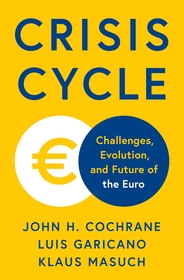
Crisis Cycle
Challenges, Evolution, and Future of the Euro
- Publisher's listprice GBP 30.00
-
14 332 Ft (13 650 Ft + 5% VAT)
The price is estimated because at the time of ordering we do not know what conversion rates will apply to HUF / product currency when the book arrives. In case HUF is weaker, the price increases slightly, in case HUF is stronger, the price goes lower slightly.
- Discount 10% (cc. 1 433 Ft off)
- Discounted price 12 899 Ft (12 285 Ft + 5% VAT)
Subcribe now and take benefit of a favourable price.
Subscribe
14 332 Ft

Availability
Estimated delivery time: In stock at the publisher, but not at Prospero's office. Delivery time approx. 3-5 weeks.
Not in stock at Prospero.
Why don't you give exact delivery time?
Delivery time is estimated on our previous experiences. We give estimations only, because we order from outside Hungary, and the delivery time mainly depends on how quickly the publisher supplies the book. Faster or slower deliveries both happen, but we do our best to supply as quickly as possible.
Product details:
- Publisher Princeton University Press
- Date of Publication 17 June 2025
- Number of Volumes Print PDF
- ISBN 9780691271606
- Binding Hardback
- No. of pages328 pages
- Size 234x155 mm
- Language English
- Illustrations 10 b/w illus. 1 table. 1771
Categories
Long description:
How the euro survived a series of crises, and how to make it more resilient
The euro has survived crises unimagined at its founding: the financial meltdown of 2007–2009, the sovereign debt crisis of 2010–2012, the pandemic, and the Russian invasion of Ukraine. The European Central Bank fought these crises with dramatic policy innovations, buying up vast amounts of debt and providing large loans to banks. But now everyone expects the ECB to intervene routinely, and the euro is more fragile as a result. Crisis Cycle recounts this history and offers recommendations for restoring a durable monetary union.
Monetary and fiscal policy are intertwined, especially in a currency union like the eurozone. Member states can be tempted to borrow and spend too much, and then count on the ECB to rescue them by printing money to buy their bonds. To avoid these disincentives, the ECB was founded with a narrow mandate: use interest rates to pursue price stability, and don’t buy sovereign debt. Debt and deficit rules would keep countries from getting into trouble.
The ECB’s emergency innovations brought back these disincentives. How can the EU avoid larger and larger bailouts? The authors argue that Europe needs a joint fiscal institution that can provide temporary help to sovereigns, a resolution mechanism so sovereign default is a motivating possibility, and bank reform that ensures sovereign default will not bring down the financial system. This timely book shows how to restore the euro’s ambitious and effective founding framework. The unique group of authors combine extensive policy experience and authoritative academic credentials.
"A Financial Times Best Economics Book of the Summer" More




